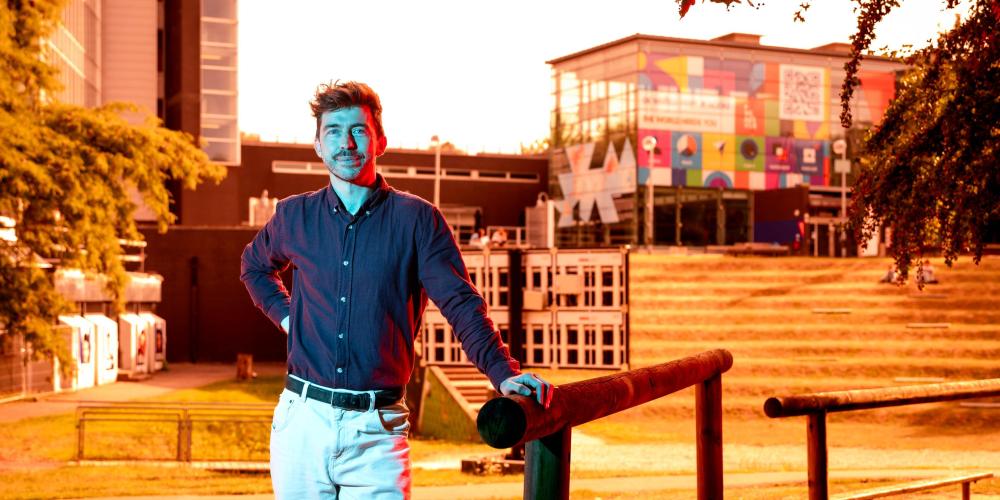
AI is evolving ‘blindly’ towards AGI. That G stands for general and makes a world of difference, predicts Professor Vincent Ginis. “The impact on the labour market and society will be profound and all-encompassing. Whistling in the dark is pointless. We must prepare for what is coming.”
Creative destruction is not a new phenomenon. In her historical novel L’Oeuvre au noir, set in the sixteenth century, Marguerite Yourcenar describes the introduction of mechanical looms. Traditional home weavers lost their jobs and were reduced to begging. Others had to work in mechanised weaving workshops, earning less. This led to social tensions and a growing gap between rich and poor. The question today: will the rise of Artificial Intelligence (AI) and Artificial General Intelligence (AGI) lead to a similar scenario? We discuss this with Vincent Ginis, professor of mathematics, physics and artificial intelligence at VUB and Harvard University.
Vincent Ginis: “Creative destruction is certainly nothing new: these stories have surfaced time and again throughout the centuries. So far, it has always ended well. Creative destruction causes shocks, but the impact is local and temporary. In the long term, it actually creates more prosperity, which benefits everyone.”
"AGI is not about automating the task, but the person performing the task"
Do you foresee a similar scenario with AI and AGI?
“That G for General really makes a big difference. AGI is AI that can perform any cognitive task behind a computer screen as well as or better than a human. That calls for humility, even from me. ChatGPT is better than me at virtually every intellectual task. AGI systems can analyse and produce complex documents and make accurate decisions based on extensive datasets. The impact on the labour market will be profound and all-encompassing.”
In what way?
“In the foreseeable future, we will face fundamental shifts in how work is organised and valued, in sectors such as legal services, software development, policy preparation, logistics, marketing, science, journalism,... Jobs will disappear or change significantly.”
Are comparisons with the past still valid?
“I have my doubts. Perhaps we are now facing a phenomenon for which no simple analogy exists. All previous industrial revolutions were about automating a task. AGI is about automating the person performing the task.”

What is actually the difference between AI and AGI?
“AGI has almost ‘blindly’ emerged from AI. The previous generation of AI allowed computers to learn from data, enabling them to perform very specific tasks. Recognising cats or dogs in a photo, for example, or labelling photos with or without people. These algorithms now fall under the label ‘narrow AI’. The difference with AGI is seismic. In the current generation of AI, unexpected so-called ‘emergent properties’ are appearing.”
What are emergent properties?
“These are tasks the system suddenly can perform, even though it wasn’t trained for them. Large language models, the LLMs, train based on a very simple recipe: the algorithm predicts the next word in a text, nothing more. But if you scale up such a language model and feed it massive amounts of data and training time, it eventually starts doing things that surprise everyone. We’ve seen this happen repeatedly since 2020. Four years ago, GPT-2, the predecessor of ChatGPT, could barely form a proper sentence. The only thing scientists noticed was that the model seemed to grasp notions of grammar.”
That was an emergent property?
“Call it a mini-emergent property. It was a harbinger of what was to come: with scaling, we see abrupt jumps in performance on tasks for which the model wasn’t explicitly trained. Today, ChatGPT can handle much more, from complex reasoning to mathematical calculations.”
What do you consider a striking example of an emergent property?
“The latest ChatGPT language models appear to be extremely – ‘superhumanly’ – good at geolocation. They weren’t trained for it, but show them a patch of grass and they’ll tell you where on the globe it is. There have been online competitions for some time where people try to guess the origin of such a patch of grass as quickly as possible. ChatGPT is the new champion.”
"People hope it won’t go that fast, but that’s whistling in the dark"
Are these emergent properties proof of true AGI?
“I believe AGI has already been achieved today. For screen-based, knowledge-intensive tasks, we see operational AGI: generalisation across domains, tool use, reasoning and self-correction. Under that working definition, AGI has arrived; not yet for physically interactive and embodied tasks.”
Sceptics say that’s insufficient proof and claim true AGI may never come.
“They change the rules during the game. Every time an LLM can do something new, they’re unimpressed and say: ‘only if this or that becomes possible, then I’ll believe it’. Until the new goal is reached, and even that turns out not to be enough. People tend to normalise things very quickly. ‘Oh, the computer can now autonomously create a song explaining the basics of quantum mechanics to Billie Eilish beats. Is that all? What’s for dinner?’ Maybe today we should agree on what AI must meet to truly be AGI…”

Why the minimisation?
“Maybe it’s whistling in the dark, hoping it won’t go that fast? That’s probably wishful thinking. AGI is coming, whether we want it or not. The first challenge is a matter of timing: when will you use it to solve a particular problem? Today? In six months? Professors told me two years ago that they were designing their assignments so students couldn’t use ChatGPT. I knew immediately: within a few months – or maybe even yesterday – ChatGPT will be able to do it. And it was. Our mindset should be: assume ChatGPT will soon be able to do it.”."
"A flood of journalistic content is coming our way, but consumers’ time is limited"
Which jobs are not immediately at risk due to AGI?
“Plumbers and nurses are in a good position. Other jobs, even those that until recently always offered job security, are under threat. Pessimistic voices believe AGI will destroy half of all entry-level office jobs in the coming years, with massive job losses in sectors like finance, sales, marketing and software, even at giants like IBM, Google and Microsoft.”
Is it mainly cognitive work that’s at risk?
“That’s certainly where AGI excels. On the other hand, many jobs are less cognitive than we sometimes think. My maths students could watch the Calculus 1 course online, but they come to my class, also for the human interaction. Learning has an interpersonal component. For many people, AI will be something that helps them work faster and more efficiently and produce more.”
Will there be demand for all that extra output?
“Much depends on the type of task. For some jobs, demand is finite. A baker who can suddenly bake a hundred times more bread in one day will eventually struggle to sell it, because the market is limited and quickly becomes saturated. The same partly applies to journalists. A flood of content is coming our way, but news consumers’ time is limited. They will feel oversaturated. For other tasks, that saturation point is reached less quickly. Think of supportive software, extra diagnostic tools, things that improve our environment.”

What about software developers? Ironically, they now risk being replaced by AI that develops software.
“Software developers are a fascinating test case, currently the subject of much debate. Never before has so much code been written by AI as in 2025: current indicators suggest that 90 percent of all code this year will be AI-generated. On the other hand, more code is being written overall than ever before. The jury is still out: does writing software fall under the category of baking bread, or can we write much more software without reaching the saturation point?”
If the first is true, what role is left for software developers in the labour market?
"I see a new role for programmers, with a stronger human factor: that of strategic bridge-builder. Large language models are an immense source of knowledge. Yet they are hard to embed in existing organisations, which are often a chaotic tangle of organically grown processes. Programmers could bridge the gap between LLMs and real-world practice. But that requires talent for human interaction and intuition about how organisations work."
If it’s the former, what can software developers still contribute to the labour market?
“I see a new role for programmers, with a greater human factor: that of strategic bridge-builder. Large language models are a huge source of knowledge. Yet they are difficult to embed in existing organisations, which are a chaotic tangle of organically grown processes. Programmers could bridge the gap between LLMs and real-world operations. That does require talent for human interaction and intuition about how organisations work.”
Can you make that concrete?
“AGI will increasingly automate bundles of tasks. The tasks that remain involve understanding context, coordinating with other people and taking responsibility. So maybe the question isn’t whether software will replace software developers, but rather: which parts of the development cycle are easy to automate, and in which tasks do context and coordination remain dominant factors? Those latter tasks will remain human work.”
"Choose studies that align as much as possible with your interests"
What study choices do you recommend for people who want to remain employable in a post-AGI world?
Vincent Ginis: “Choose something that aligns as much as possible with your interests, something that makes you feel upon graduation: I’ve become more human, I’ve become more the person I want to be. The idea that education prepares you for a career is relatively recent, only gaining traction in the last century. In ancient Greece, education had to be enriching and humanising, bringing out your potential. Assuming jobs will disappear or be performed more efficiently, I think we’ll see a renaissance of that kind of education.”
So you can even choose art history?
“Absolutely, provided it interests you! Research shows that young people who complete such a programme, for example, get better results from AI generators than those who followed a more applied course. Graphic design is not doomed. Precisely because there are so many possibilities, the role of the graphic designer becomes even more important.”
"We need to think about a guaranteed minimum income"
Despite the ominous predictions, trade unions remain remarkably silent about the rise of AGI.
Vincent Ginis: “It’s barely mentioned in the coalition agreement either. Yet the economic and social impact will be enormous. The chief economist of OpenAI predicts that AGI’s productivity gains will lead to a wealth explosion – by the end of 2026, the US GDP could rise by ten percent. That may be an overestimation, but still. The question is: how do we ensure that this extra wealth doesn’t just flow to a club of multi-billionaires, but also to the people who lose their jobs due to AGI and to society as a whole?”
You tell us?
“The biggest believers in AGI, people like Sam Altman of OpenAI, advocate for a guaranteed minimum income, especially in regions where the economy might collapse. This debate urgently needs to be held.”
Co-researchers and interdisciplinary science
Training AGI models requires immense amounts of energy and cooling water. Proponents say we must accept this environmental toll, because AGI will fix the climate and cure cancer. Is the dream they’re selling us accurate?
Vincent Ginis: “We actually already know how to tackle climate change. It’s more a matter of willingness. And curing cancer? Some impressive things are happening. In 2015, scientists formulated a hypothesis about the impact of certain genes on a disease. They spent ten years researching it but never published their findings. So they weren’t available online. Google presented the same hypothesis to its reasoning engine Gemini 2.5 Pro. Less than three days later, it had the same answer as the scientists. So scientists can use AGI as a co-researcher that thinks along, makes suggestions and searches for patterns in large datasets.”
“I also believe AGI will enable far-reaching interdisciplinary collaboration"
According to Vincent Ginis, AGI also enables a massive democratisation of coding – a skill that researchers in the social sciences and many other fields currently lack. They can now ask AGI to write code for their research.
Vincent Ginis: “I also believe AGI will enable far-reaching interdisciplinary collaboration. Researchers often work in scientific silos. Outside our own field, we’re all laypeople. As a mathematician, I don’t understand much of the papers published by VUB colleagues like cancer researcher Damya Laoui. Thanks to AGI, I can now make that translation, and we can explore what we can mean to each other. For example, I’m currently working on a paper about neuroscience. The paper empirically demonstrates a certain insight into how the human brain works, but couldn’t determine the underlying mechanism. I’ve now explored with ChatGPT whether we can transpose the entire issue to the world of AI. Maybe that way we’ll be able to uncover the mechanism. I see a bright future for this kind of interdisciplinary collaboration.”
BIO
Vincent Ginis (Data Analytics Lab) is professor of mathematics, physics and artificial intelligence at VUB and visiting professor at Harvard University. He teaches several courses in science and engineering and has published leading research in photonics and data analysis, with more than 20 international articles and 40 conference presentations.